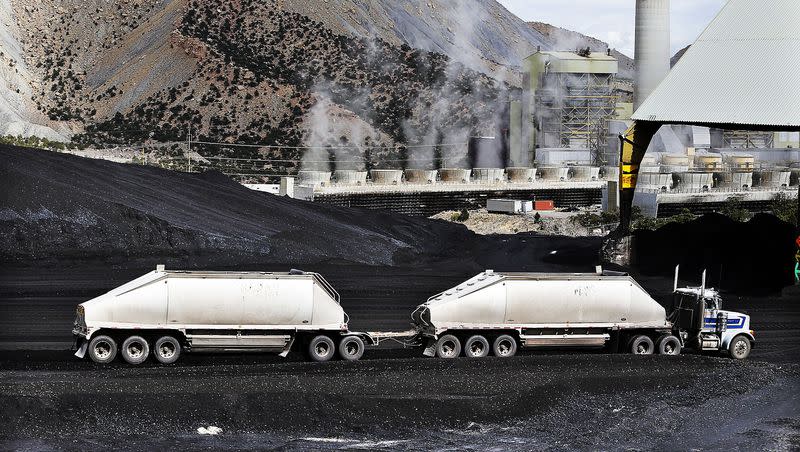U.S. power sector, states say Biden’s carbon rule is unrealistic

The nation’s largest power providers warn a new rule proposed by the Biden administration relies on technology not yet proven to scale and as a result will cause widespread power outages to an already overstrained grid should it be adopted.
In the West, Wyoming Energy Authority and the Utah Division of Air Quality said the carbon reductions required under the U.S. Environmental Agency’s proposal are particularly problematic for gas-fired power plants and would hasten the retirement of coal-fired generators.
Bryce Bird, the state’s air quality division director, said while PacifiCorp has already proposed early retirement of the Hunter and Huntington Power plants in its latest planning document, it is unclear if an alternative baseload power will be developed in time to make that shift.
“... These units may be ultimately needed over a longer period to help ensure resource adequacy and reliability, and importantly to support the very transition to lower-emitting resources that the proposed rule seeks to facilitate.”
What the rule proposes: The measure would establish a reduction rate of 90% of carbon dioxide emissions at electrical generating units — for natural gas fired power plants. That deadline is 2030. For combustion units, the compliance deadline would be 2032 or 2035, depending on the plant’s category.
Those reductions would come in the form of carbon capture and sequestration and co-firing with hydrogen.
“UDAQ strongly believes that the proposed compliance deadlines are unrealistic,” Bird wrote. “Furthermore, natural gas co-firing and especially unproven carbon capture storage will require a significant amount of time and resources to put in place, not the mere three to five years, respectively, that the EPA estimates.”
EPA says its new standards would avoid more than 600 million metric tons of carbon dioxide pollution and deliver up to $85 billion in public health and environmental benefits.
The rules are being praised by environmental groups seeking the abandonment of fossil fuels.
“(The) proposed standards mark a pivotal turning point, with Administrator Michael Regan rightfully and necessarily moving to hold coal- and gas-fired power plants to account for their ongoing carbon pollution,” said Julie McNamara, deputy policy director of the Climate and Energy Program at the Union of Concerned Scientists.
“As important as these proposed standards are, gaps still remain. EPA must strengthen its standards for existing gas plants, requiring deeper emissions reductions on faster timelines— and it must extend requirements across a significantly expanded range of plants.”
Too much, too early and too undeveloped?
Wyoming Energy Authority, like Bird, argued that the rule is untenable.
“The proposed rule contains unproven performance standards. While carbon capture systems are considered commercial and available for deployment, a capture rate of 90% has not been demonstrated at scale for all types and scales of electrical generating units,” wrote Rob Creager, executive director.
According to the International Energy Association, there are 40 carbon capture systems operating in the world. EPA’s proposal would target about 3,400 coal and natural gas plants in the United States.
The nation’s only commercial scale carbon capture plant, Petra Nova, cost $1 billion and was under development for years before receiving approval for construction to begin in 2014 at a coal fired power plant. It shut down in 2020 due to plunging oil prices but is slated to restart operations. By then nrg, one of the nation’s largest power providers, had sold its 50% stake in the company.
The company had said it met its target carbon pollution reduction rate of 90%, but the Institute for Energy Economics and Financial Analysis said the company was never required to document those results and EPA’s own emissions calculations at the plant show a number close to 65% to 75%.
The rule’s health benefits: EPA says the carbon emission reductions that will result are equivalent to reducing the annual emissions of 137 million passenger vehicles, roughly half the cars in the United States. By doing so, simply in 2030 alone, EPA asserts these health impacts will be avoided:
Approximately 1,300 premature deaths.
More than 800 hospital and emergency room visits.
More than 300,000 cases of asthma attacks.
38,000 school absence days.
66,000 lost workdays.
Sustaining the grid and consumer energy costs
Bird said beyond the uncertainty of the technology available to meet the Biden administration’s proposed new emission standards on the timeline mandated, the pocketbook needs to be considered.
“At the very least, such outcomes could result in skyrocketing prices for electricity on the western grid, and at worst, they could lead to ‘controlled, rolling blackouts’ or even unplanned outages.
Creager echoed that sentiment, noting that EPA’s statement about the standards being compatible with reliable and affordable electricity for the nation is contrary to reality.
Already, he said, 55,834 megawatts of existing coal is scheduled for retirement before 2032.
Hundreds of additional megawatts are at risk of retirement due to a suite of other proposed EPA regulations, such as the ozone transport rule, he added.
Related
“It is difficult to see how additional regulations resulting in more coal units being prematurely retired is ‘compatible’ with ‘the nation’s overall need for a reliable supply’ of electricity. The North American Electric Reliability Corporation (NERC), PJM, ERCOT, SPP and the Midcontinent Independent System Operator (MISO) all are sounding the alarm about resource adequacy concerns threatening the reliability of the grid.”

